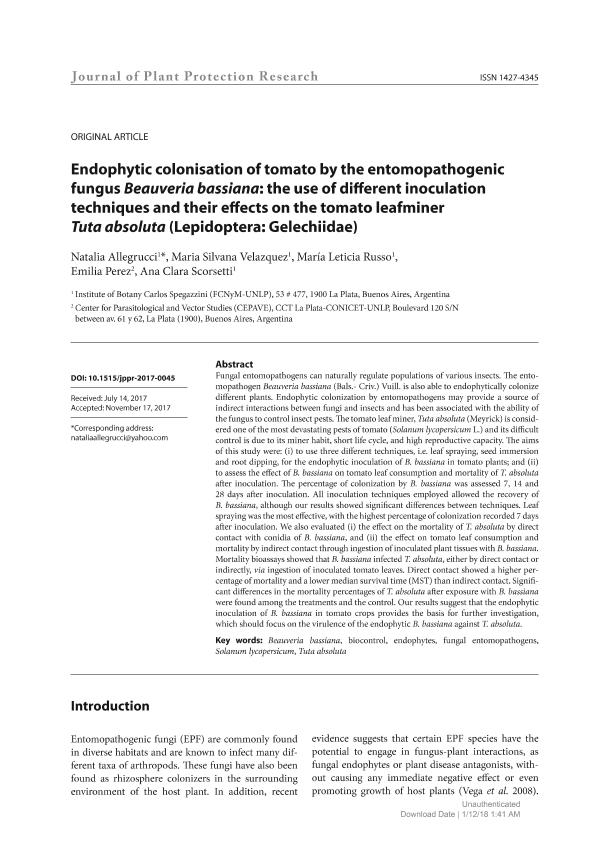Mostrar el registro sencillo del ítem
dc.contributor.author
Allegrucci, Natalia

dc.contributor.author
Velázquez, María Silvana

dc.contributor.author
Russo, Maria Leticia

dc.contributor.author
Pérez, María Emilia

dc.contributor.author
Scorsetti, Ana Clara

dc.date.available
2018-06-22T19:50:13Z
dc.date.issued
2017-11
dc.identifier.citation
Allegrucci, Natalia; Velázquez, María Silvana; Russo, Maria Leticia; Pérez, María Emilia; Scorsetti, Ana Clara; Endophytic colonisation of tomato by the entomopathogenic fungus Beauveria bassiana: The use of different inoculation techniques and their effects on the tomato leafminer Tuta absoluta (Lepidoptera: Gelechiidae); Polish Academy of Sciences; Journal of Plant Protection Research; 57; 4; 11-2017; 331-337
dc.identifier.uri
http://hdl.handle.net/11336/49743
dc.description.abstract
Fungal entomopathogens can naturally regulate populations of various insects. The entomopathogen Beauveria bassiana (Bals.- Criv.) Vuill. is also able to endophytically colonize different plants. Endophytic colonization by entomopathogens may provide a source of indirect interactions between fungi and insects and has been associated with the ability of the fungus to control insect pests. The tomato leaf miner, Tuta absoluta (Meyrick) is considered one of the most devastating pests of tomato (Solanum lycopersicum L.) and its difficult control is due to its miner habit, short life cycle, and high reproductive capacity. The aims of this study were: (i) to use three different techniques, i.e. leaf spraying, seed immersion and root dipping, for the endophytic inoculation of B. bassiana in tomato plants; and (ii) to assess the effect of B. bassiana on tomato leaf consumption and mortality of T. absoluta after inoculation. The percentage of colonization by B. bassiana was assessed 7, 14 and 28 days after inoculation. All inoculation techniques employed allowed the recovery of B. bassiana, although our results showed significant differences between techniques. Leaf spraying was the most effective, with the highest percentage of colonization recorded 7 days after inoculation. We also evaluated (i) the effect on the mortality of T. absoluta by direct contact with conidia of B. bassiana, and (ii) the effect on tomato leaf consumption and mortality by indirect contact through ingestion of inoculated plant tissues with B. bassiana. Mortality bioassays showed that B. bassiana infected T. absoluta, either by direct contact or indirectly, via ingestion of inoculated tomato leaves. Direct contact showed a higher percentage of mortality and a lower median survival time (MST) than indirect contact. Significant differences in the mortality percentages of T. absoluta after exposure with B. bassiana were found among the treatments and the control. Our results suggest that the endophytic inoculation of B. bassiana in tomato crops provides the basis for further investigation, which should focus on the virulence of the endophytic B. bassiana against T. absoluta.
dc.format
application/pdf
dc.language.iso
eng
dc.publisher
Polish Academy of Sciences

dc.rights
info:eu-repo/semantics/openAccess
dc.rights.uri
https://creativecommons.org/licenses/by-nc-sa/2.5/ar/
dc.subject
Beauveria Bassiana
dc.subject
Biocontrol
dc.subject
Endophytes
dc.subject
Fungal Entomopathogens
dc.subject
Solanum Lycopersicum
dc.subject
Tuta Absoluta
dc.subject.classification
Otras Ciencias Biológicas

dc.subject.classification
Ciencias Biológicas

dc.subject.classification
CIENCIAS NATURALES Y EXACTAS

dc.title
Endophytic colonisation of tomato by the entomopathogenic fungus Beauveria bassiana: The use of different inoculation techniques and their effects on the tomato leafminer Tuta absoluta (Lepidoptera: Gelechiidae)
dc.type
info:eu-repo/semantics/article
dc.type
info:ar-repo/semantics/artículo
dc.type
info:eu-repo/semantics/publishedVersion
dc.date.updated
2018-06-22T15:06:40Z
dc.identifier.eissn
1899-007X
dc.journal.volume
57
dc.journal.number
4
dc.journal.pagination
331-337
dc.journal.pais
Polonia

dc.description.fil
Fil: Allegrucci, Natalia. Universidad Nacional de la Plata. Facultad de Ciencias Naturales y Museo. Instituto de Botánica Spegazzini; Argentina. Consejo Nacional de Investigaciones Científicas y Técnicas; Argentina
dc.description.fil
Fil: Velázquez, María Silvana. Universidad Nacional de la Plata. Facultad de Ciencias Naturales y Museo. Instituto de Botánica Spegazzini; Argentina. Consejo Nacional de Investigaciones Científicas y Técnicas; Argentina
dc.description.fil
Fil: Russo, Maria Leticia. Universidad Nacional de la Plata. Facultad de Ciencias Naturales y Museo. Instituto de Botánica Spegazzini; Argentina. Consejo Nacional de Investigaciones Científicas y Técnicas; Argentina
dc.description.fil
Fil: Pérez, María Emilia. Consejo Nacional de Investigaciones Científicas y Técnicas. Centro Científico Tecnológico Conicet - La Plata. Centro de Estudios Parasitológicos y de Vectores. Universidad Nacional de La Plata. Facultad de Ciencias Naturales y Museo. Centro de Estudios Parasitológicos y de Vectores; Argentina
dc.description.fil
Fil: Scorsetti, Ana Clara. Universidad Nacional de la Plata. Facultad de Ciencias Naturales y Museo. Instituto de Botánica Spegazzini; Argentina. Consejo Nacional de Investigaciones Científicas y Técnicas; Argentina
dc.journal.title
Journal of Plant Protection Research
dc.relation.alternativeid
info:eu-repo/semantics/altIdentifier/doi/http://dx.doi.org/10.1515/jppr-2017-0045
dc.relation.alternativeid
info:eu-repo/semantics/altIdentifier/url/https://content.sciendo.com/view/journals/jppr/ahead-of-print/article-10.1515-jppr-2017-0045.xml
Archivos asociados
